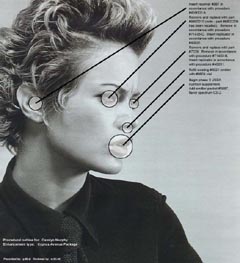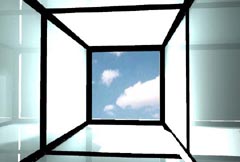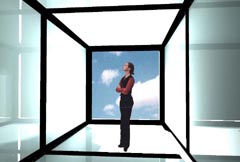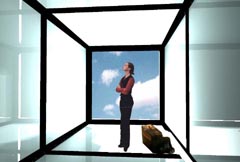In order to continue our belief that we are non-void, we must inhabit the void. For to be the void inhabiting the non-void is to be nothing; no room is left for humanity and for existence. This thesis builds from the belief that we are non-void inhabiting the void. That by not objectifying ourselves, by not filling the void with non-void, we allow ourselves to exist within the void. “Man produces himself by refusing his image, in refusing to be reproduced.”34 By not objectifying life, perception, and humanity we leave ourselves with life, perception and humanity. By not creating reality, we assure our own. By not objectifying our thesis, we leave ourselves with our thesis.
By objectifying our anti-thesis exterior to ourselves, we create the thesis within ourselves. Thus we want to create a world without belief so that we can believe. We want to construct a world of nihilism fulfilled so that we can revel in the fulfillment of our own belief within ourselves. We want to create a world of design so that we can be the reality within it.
It is the blank canvas and cold hard examination room, which cause in us the urge of life, the artistic impulse, the kinetic potential. The feeling in the viewer is active and induced rather than empathetic and distant. It is in the coldest and most comfortless rooms that we feel ourselves most. By not imbedding the object with emotion, we leave those unspeakables unspoken, and those undescribables undescribed.
Loos understood that ornament embodies belief; it consumes the object which it is placed on. It fills the void around the object so that the object no longer exists within a void, and therefore no longer exists. It is by the placement of a cold hard plain exterior without belief that we are left with belief within ourselves.
“Mies takes a step back and remains silent”35 The void is more saturated with kinetic potential the more that potential energy is intentionally left untapped. The architecture of exclusion created the non-architecture of inclusion.
“For any expression that is made up of few formal components and little apparent associative content ? any art, that is to say, which conceals art ? is likely to induce a perceptual horror vacui in the interpreter, tempting him to fill in the space that the art has emptied out, as it were, and thus to account for the emptying.”36
“The interplay of column and wall eventually ended with the total dissolution of the wall and the crystallization of a spatial void through which the body, wrapped in various layers of sheer glass, could experience the silence caused by the absence of any representational intention.”37

















 The self-animator projects our personal dreams to us through our senses. The self animator is the end result of objectification, of total effect, of personalized utopia, of seeing ourselves.
The self-animator projects our personal dreams to us through our senses. The self animator is the end result of objectification, of total effect, of personalized utopia, of seeing ourselves. 











 Wtihin the void, you feel your self.
Wtihin the void, you feel your self. 
 It is like living in a museum, in which life is the art.
It is like living in a museum, in which life is the art. 
 A tension, a difference, is what allows the viewer an awareness of their occupation of space.
A tension, a difference, is what allows the viewer an awareness of their occupation of space. 